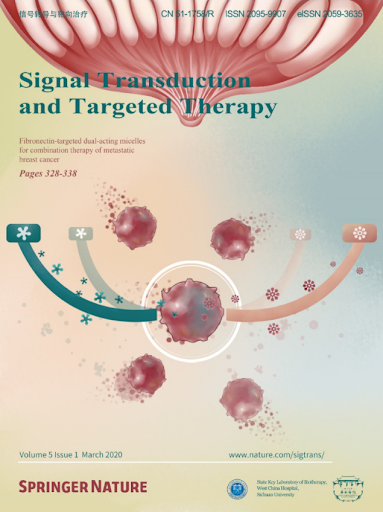核苷类逆转录酶抑制剂抑制长穿插核元素-1可减轻血管钙化。
IF 52.7
1区 医学
Q1 BIOCHEMISTRY & MOLECULAR BIOLOGY
引用次数: 0
摘要
血管钙化(VC)是一种重要的血管病理事件,导致心血管疾病的患病率和病死率上升。然而,缺乏有效的VC治疗策略主要归因于对其潜在分子机制的不完整理解。在这项研究中,我们发现长穿插核元素1 (LINE1)在人类个体和小鼠模型的钙化动脉中都显着上调。从机制上讲,通过添加核苷逆转录酶抑制剂(NRTIs,一类经过验证的LINE1抑制剂)沉默LINE1表达或抑制其活性,可以有效地阻止血管平滑肌细胞(VSMCs)的成骨重编程。此外,NRTIs治疗可显著减轻慢性肾脏疾病(CKD)诱导和维生素d3超载VC小鼠模型中的VC。RNA测序分析显示,LINE1缺失(通过小干扰RNA)或NRTIs干预下调了vsmc中的cGAS-STING信号通路及其相关炎症基因。功能验证表明,刺激cGAS-STING通路可加重VC,而其药理抑制作用可减轻VC。值得注意的是,我们发现LINE1衍生的cDNA是cGAS-STING途径的直接激活剂,表明LINE1抑制通过阻断cGAS-STING激活和随后的炎症反应来抑制VC。临床上,一项涉及1785名参与者的横断面研究显示,接受NRTIs治疗的患者VC发病率显著降低,钙化评分降低。多因素logistic回归分析进一步证实nrti的使用是预防VC发生和进展的独立保护因素。总的来说,这些发现确立了LINE1作为VC的有希望的治疗靶点,并突出了nrti作为开发抗VC新策略的潜在候选者。本文章由计算机程序翻译,如有差异,请以英文原文为准。
Inhibition of long interspersed nuclear element-1 by nucleoside reverse transcriptase inhibitors attenuates vascular calcification.
Vascular calcification (VC) is a critical vascular pathological event, contributing to the rise in both the prevalence and fatality of cardiovascular diseases. However, the lack of effective therapeutic strategies for VC is attributed primarily to the incomplete understanding of its underlying molecular mechanisms. In this study, we discovered that long interspersed nuclear element 1 (LINE1) was significantly upregulated in the calcified arteries of both human individuals and mouse models. Mechanistically, silencing LINE1 expression or inhibiting its activity with adding nucleoside reverse transcriptase inhibitors (NRTIs, a class of validated LINE1 inhibitors) effectively prevented the osteogenic reprogramming of vascular smooth muscle cells (VSMCs). Moreover, NRTIs treatment substantially mitigated VC in chronic kidney disease (CKD)-induced and vitamin D3-overloaded VC mouse models. RNA sequencing analysis revealed that LINE1 depletion (via small interfering RNA) or NRTIs intervention downregulated the cGAS-STING signaling pathway and its associated inflammatory genes in VSMCs. Functional validation revealed that stimulation of the cGAS‒STING pathway exacerbated VC, whereas its pharmacological inhibition alleviated VC. Notably, we identified LINE1-derived cDNA as a direct activator of the cGAS‒STING pathway, demonstrating that LINE1 inhibition suppresses VC by blocking cGAS‒STING activation and subsequent inflammatory responses. Clinically, a cross-sectional study involving 1,785 participants revealed that patients receiving NRTIs therapy presented a significantly lower incidence of VC and reduced calcification scores. Multivariate logistic regression analysis further confirmed that NRTIs use is an independent protective factor against VC incidence and progression. Collectively, these findings establish LINE1 as promising therapeutic targets for VC and highlight NRTIs as potential candidates for developing novel strategies against VC.
求助全文
通过发布文献求助,成功后即可免费获取论文全文。
去求助
来源期刊

Signal Transduction and Targeted Therapy
Biochemistry, Genetics and Molecular Biology-Genetics
CiteScore
44.50
自引率
1.50%
发文量
384
审稿时长
5 weeks
期刊介绍:
Signal Transduction and Targeted Therapy is an open access journal that focuses on timely publication of cutting-edge discoveries and advancements in basic science and clinical research related to signal transduction and targeted therapy.
Scope: The journal covers research on major human diseases, including, but not limited to:
Cancer,Cardiovascular diseases,Autoimmune diseases,Nervous system diseases.
 求助内容:
求助内容: 应助结果提醒方式:
应助结果提醒方式:


